As a dog owner, I often find myself wondering about the safety of certain human foods for my furry friend. One such food that often comes to mind is quinoa. Can dogs eat quinoa? Is it a safe and nutritious addition to their diet? In this comprehensive guide, I will explore the topic of feeding quinoa to dogs, its health benefits, and the proper way to incorporate it into their meals.
Key Takeaways:
- Quinoa is generally safe for dogs to eat and can provide health benefits.
- It is important to introduce quinoa gradually and monitor your dog’s reaction.
- Cooking quinoa and avoiding harmful ingredients is essential for your dog’s safety.
- Quinoa is a nutritious grain that offers protein, vitamins, and minerals for your dog’s well-being.
- Consulting a veterinarian is recommended before introducing quinoa or any new food into your dog’s diet.
Is Quinoa Safe for Dogs?
Many pet owners wonder if quinoa is safe for their furry friends. Quinoa is generally considered safe for dogs to eat, but it’s essential to understand the potential risks and take necessary precautions. One concern is the presence of saponin in quinoa, which can cause digestive issues in some dogs. Luckily, there are steps you can take to ensure your dog’s safety when feeding them quinoa.
Understanding the Role of Saponin
Saponin is a natural compound found in quinoa that can lead to gastrointestinal disturbances in dogs. It has a bitter taste and can cause vomiting, diarrhea, or stomach discomfort. However, the amount of saponin in quinoa is usually low and not likely to cause significant harm. Washing quinoa thoroughly before cooking it can help remove most of the saponin, minimizing the risk of digestive issues in dogs.
Preventing Digestive Issues in Dogs
When introducing quinoa to your dog’s diet, it’s important to start with small amounts and monitor their reaction. If your dog shows any signs of digestive upset, such as vomiting or diarrhea, discontinue feeding them quinoa and consult your veterinarian. Some dogs may simply have difficulty digesting quinoa, and it may not be suitable for their individual needs.
| Is Quinoa Safe for Dogs? | Benefits | Precautions |
|---|---|---|
| Generally, yes, but some dogs may have difficulty digesting it. | Quinoa is a nutritious grain packed with protein, vitamins, and minerals. | Start with small amounts, wash quinoa to remove saponin, and monitor your dog’s reaction. |
Guidelines for Feeding Quinoa to Dogs
When it comes to incorporating quinoa into your dog’s diet, there are a few important guidelines to follow. By following these guidelines, you can ensure that your dog enjoys the nutritional benefits of quinoa while minimizing any potential risks or digestive issues. Here are some key tips:
- Cook quinoa: Before feeding quinoa to your dog, it’s crucial to cook it first. Cooking the quinoa makes it easier for your dog to digest and prevents any potential stomach upset.
- Avoid harmful ingredients: When preparing quinoa for your dog, make sure to avoid adding any harmful ingredients such as salt, garlic, or onions. These ingredients can be toxic to dogs and should be avoided in their meals.
- Start with small portions: To introduce quinoa to your dog’s diet, start with small portions and observe their reaction. Watch for any signs of vomiting, diarrhea, or constipation, which may indicate that your dog is not tolerating quinoa well.
- Consult a veterinarian: Before introducing any new food into your dog’s diet, it’s always a good idea to consult with your veterinarian. They can provide guidance specific to your dog’s needs and ensure that quinoa is a suitable addition to their diet.
By following these guidelines, you can safely incorporate quinoa into your dog’s meals or offer it as a treat. Remember to cook the quinoa, avoid harmful ingredients, start with small portions, and consult your veterinarian for personalized advice.
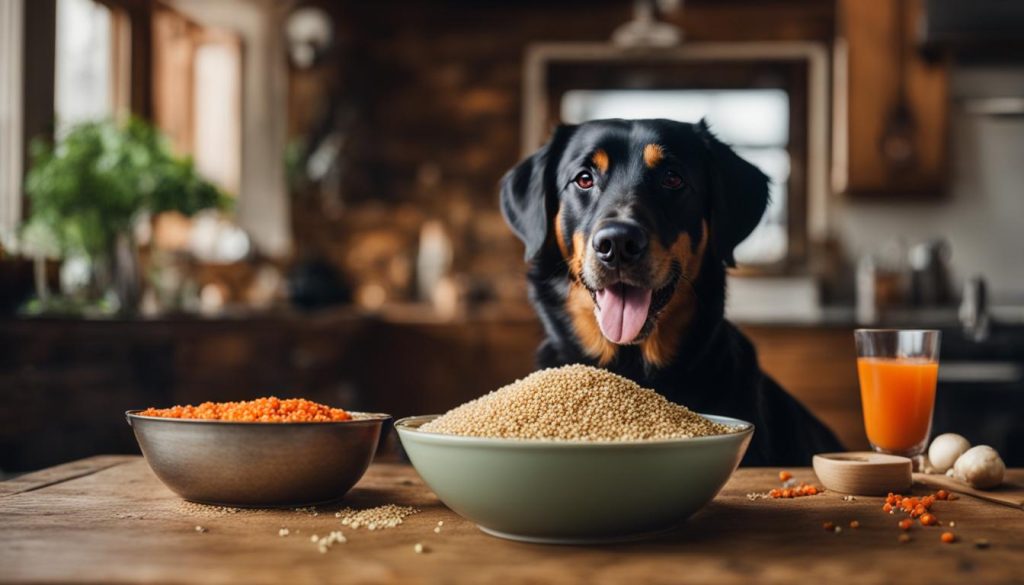
Table: Potential Benefits and Risks of Feeding Quinoa to Dogs:
| Benefits of Feeding Quinoa to Dogs | Risks of Feeding Quinoa to Dogs |
|---|---|
| High in protein | Potential digestive issues |
| Rich in vitamins and minerals | Saponin content (can be reduced by washing quinoa) |
| Provides essential amino acids | Individual dog’s tolerance may vary |
This table provides a summary of the potential benefits and risks of feeding quinoa to dogs. While quinoa offers nutritional benefits such as high protein content, vitamins, minerals, and essential amino acids, there is a possibility of digestive issues due to the saponin content. However, these risks can be mitigated by washing quinoa before cooking and starting with small portions to monitor your dog’s tolerance.
Health Benefits of Quinoa for Dogs
Quinoa is a highly nutritious grain that can provide several health benefits for dogs. Its nutritional profile makes it an excellent addition to a canine diet. Here are some key health benefits of quinoa for dogs:
- Rich in Protein: Quinoa is a complete protein source, meaning it contains all nine essential amino acids that dogs need for optimal health. Protein is essential for muscle development, tissue repair, and overall growth in dogs.
- Abundance of Vitamins and Minerals: Quinoa is packed with vitamins and minerals that contribute to a dog’s overall well-being. It is a good source of vitamins B6, E, and niacin. Additionally, quinoa is rich in minerals like magnesium, manganese, phosphorus, and zinc.
- Beneficial Dietary Fiber: Quinoa contains dietary fiber, which aids in digestion and helps maintain a healthy gastrointestinal tract. Fiber can also contribute to proper weight management in dogs.
- Low in Fat: Quinoa is a low-fat grain, making it a suitable choice for dogs that require a diet low in fat. It can be a valuable addition to a weight management plan for overweight or obese dogs.
Quinoa offers several health benefits for dogs, including its high protein content, abundance of vitamins and minerals, beneficial dietary fiber, and low-fat content. Incorporating quinoa into a dog’s diet can support their overall health and well-being.
When feeding quinoa to your dog, it’s important to ensure it is cooked thoroughly to enhance digestibility. You can prepare quinoa by boiling it in water or low-sodium chicken broth without adding any harmful ingredients like salt, garlic, or onions. Before introducing quinoa into your dog’s diet, it’s always best to consult with a veterinarian to ensure it aligns with their specific dietary needs.
| Nutrient | Amount per 100g |
|---|---|
| Protein | 14g |
| Fat | 6g |
| Carbohydrates | 64g |
| Dietary Fiber | 7g |
| Calcium | 47mg |
| Iron | 4mg |
Quinoa is a versatile grain that can be incorporated into your dog’s meals or served as a treat. However, moderation is key, as excessive consumption of quinoa can lead to digestive issues or an unbalanced diet. It’s essential to monitor your dog’s reaction when introducing quinoa and make adjustments as necessary. By understanding the health benefits of quinoa for dogs and following proper feeding guidelines, you can provide your furry friend with a nutritious and delicious addition to their diet.
Image source: https://seowriting.ai/32_6.png
Introducing Quinoa to Your Dog’s Diet
When it comes to introducing quinoa to your dog’s diet, it’s important to start with small amounts and carefully monitor your dog’s reaction. While quinoa is generally safe for dogs, every dog may have a different tolerance level, and it’s crucial to ensure that they can digest it well. By taking a gradual approach and paying attention to your dog’s response, you can determine if quinoa is a suitable addition to their meals or as a special treat.
Begin by offering your dog a small portion of cooked quinoa to see how they handle it. Watch for any signs of digestive upset, such as vomiting, diarrhea, or constipation. If your dog shows any negative reactions, it may be an indication that quinoa does not agree with their system and should be avoided in the future.
On the other hand, if your dog tolerates quinoa well, you can gradually increase the portion size over time. This will allow their digestive system to adjust and ensure that they can continue to enjoy the benefits of this nutritious grain. Remember to strike a balance in your dog’s overall diet and consult with a veterinarian for guidance specific to your dog’s health and dietary needs.
Implementing a Smooth Transition
When introducing quinoa to your dog’s diet, it’s essential to make the transition as smooth as possible. It’s advisable to mix the cooked quinoa with your dog’s regular food initially. This will help them become familiar with the taste and texture of quinoa without overwhelming their palates. Gradually, you can increase the proportion of quinoa to their regular food until they are consuming a comfortable amount.
Quote: “Starting with small amounts and closely monitoring your dog’s reaction is key when introducing quinoa to their diet. Every dog is different, and it’s important to tailor their diet accordingly.” – Veterinary Nutritionist
Remember to maintain a balanced diet for your dog by incorporating other dog-friendly grains and ingredients. Quinoa can complement other nutritious foods, such as pumpkin or vegetables, to provide a well-rounded meal for your pet. By introducing quinoa in moderation and observing your dog’s response, you can determine if it’s a suitable addition to their diet.
| Benefits of Introducing Quinoa to Your Dog’s Diet | Considerations |
|---|---|
| Provides additional protein, vitamins, and minerals | Start with small amounts to test for any adverse reactions |
| Supports a healthy immune system | Monitor for signs of digestive issues |
| Can be included in meals or served as a special treat | Consult with a veterinarian for personalized advice |
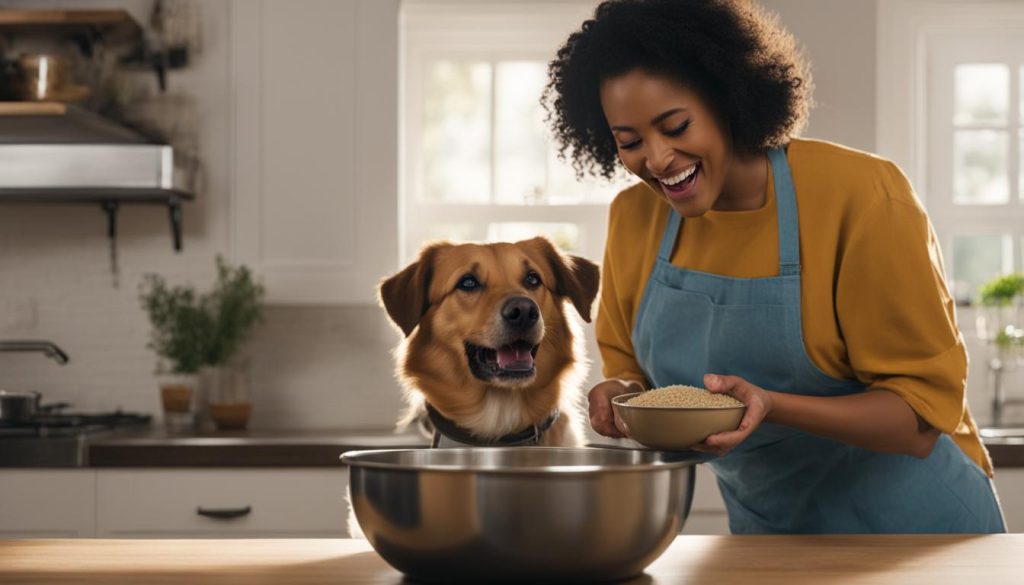
Introducing quinoa to your dog’s diet can be a beneficial choice, but it’s essential to do so cautiously. By starting with small amounts, monitoring your dog’s reaction, and seeking guidance from a veterinarian, you can ensure a smooth and successful transition. Remember to prioritize your dog’s health and well-being when introducing any new food to their diet.
Other Dog-Friendly Grains
Dogs can safely consume a variety of grains that provide similar nutritional benefits to quinoa. Here are some alternative grains that are considered safe and healthy for dogs:
- Brown Rice: A nutritious and easily digestible grain that is often used in commercial dog foods. It is rich in fiber and can help regulate digestion in dogs.
- Oats: Another dog-friendly grain, oats are a good source of fiber, protein, and various vitamins and minerals. They can be cooked and added to your dog’s meals or used in homemade treats.
- Barley: Barley is a nutrient-rich grain that offers dietary fiber, vitamins, and minerals. It can be cooked and served as a side dish or mixed with your dog’s regular food.
These grains can be prepared and served in a similar way to quinoa, providing dogs with additional nutrients and variety in their diet. However, it’s important to introduce new grains gradually and monitor your dog’s response to ensure they tolerate them well. Consulting with your veterinarian can also help determine the most suitable grains for your dog’s specific dietary needs.
Comparing Nutritional Profiles
| Grain | Protein Content | Fiber Content | Vitamin Content | Mineral Content |
|---|---|---|---|---|
| Brown Rice | 7g per 100g | 2g per 100g | Vitamin B1, B3, B6 | Potassium, magnesium |
| Oats | 12g per 100g | 10g per 100g | Vitamin B1, B5, and folate | Iron, zinc, selenium |
| Barley | 9g per 100g | 17g per 100g | Vitamin B1, B3, B6 | Manganese, selenium |
As shown in the table above, these grains offer different nutritional profiles. While quinoa provides higher protein content, oats and barley are higher in fiber. Brown rice offers a good balance of protein and fiber. Each grain also contains various vitamins and minerals that contribute to a well-rounded diet for dogs.
When incorporating these grains into your dog’s diet, it’s essential to ensure they are cooked properly and free from any harmful ingredients. Start with small amounts, observe your dog’s response, and make adjustments accordingly. Remember, a balanced and varied diet is key to maintaining your dog’s overall health and well-being.
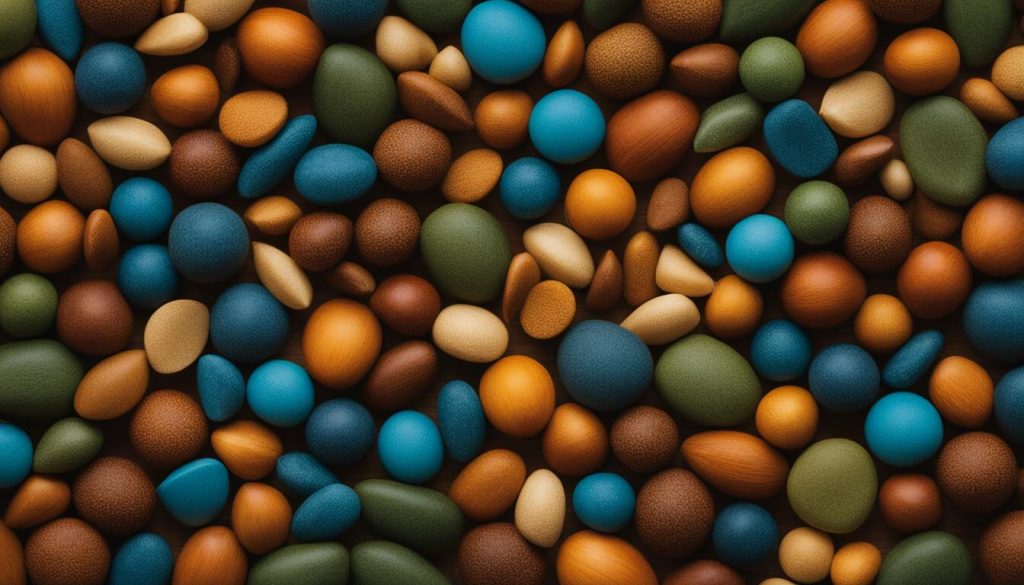
Precautions When Feeding Quinoa to Dogs
When it comes to incorporating quinoa into your dog’s diet, it’s important to take certain precautions to ensure their safety and well-being. While quinoa is generally safe for dogs to eat, there are some toxic ingredients that may be present in quinoa recipes that can be harmful to your furry friend. To safeguard your dog’s health, it’s essential to be mindful of what you’re feeding them.
One of the main concerns when feeding quinoa to dogs is the inclusion of ingredients that are toxic to them. Many quinoa recipes for humans contain seasonings like salt, garlic, and onions, which can be harmful to dogs if consumed in large quantities. These ingredients can cause various health issues such as anemia, digestive problems, or even toxicity. Therefore, it’s crucial to avoid giving your dog quinoa directly from your plate and instead cook quinoa separately for them, using plain water or low-sodium chicken broth without any added harmful ingredients.
Another precaution to keep in mind is ensuring that any quinoa you feed your dog has been properly cooked and prepared. Raw or undercooked quinoa can be difficult for dogs to digest, leading to digestive issues such as vomiting, diarrhea, or constipation. By thoroughly cooking quinoa, you can make it easier for your dog to break down and absorb the nutrients without any digestive discomfort.
It’s vital to take precautions when feeding quinoa to dogs to avoid any potential harm from toxic ingredients and ensure proper digestion. Cook quinoa separately for your dog and avoid adding harmful ingredients such as salt, garlic, or onions to their meals.
| Precautions When Feeding Quinoa to Dogs | Key Points |
|---|---|
| Avoid harmful ingredients | Do not include salt, garlic, or onions in quinoa recipes for dogs |
| Cook thoroughly | Ensure quinoa is properly cooked to aid digestion |
| Feed separately | Cook quinoa separately for your dog, using plain water or low-sodium chicken broth |
By following these precautions, you can safely incorporate quinoa into your dog’s diet and provide them with the nutritional benefits of this wholesome grain. Remember, it’s always recommended to consult with a veterinarian before introducing any new food into your dog’s diet to ensure it aligns with their specific needs and health requirements.
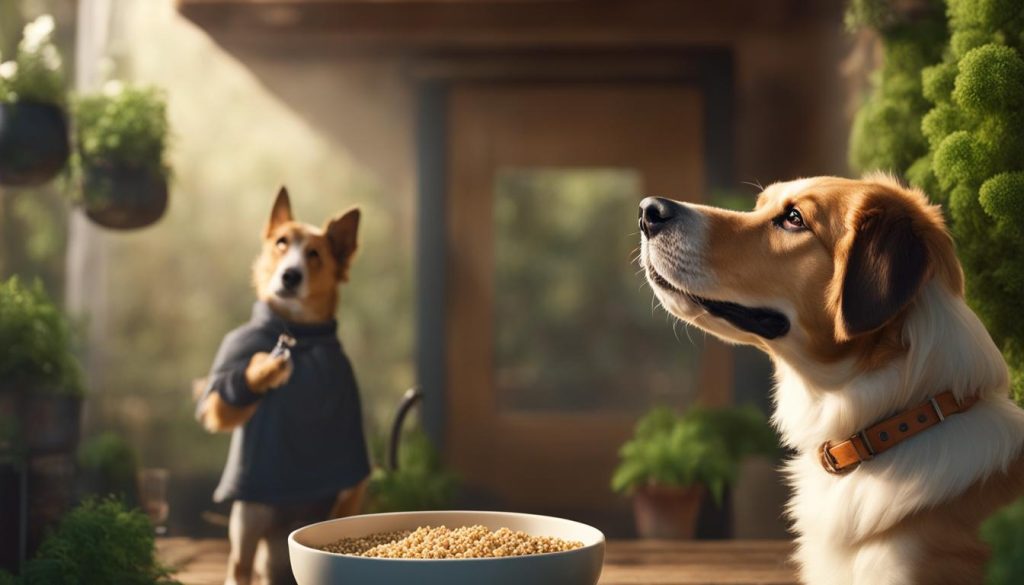
Incorporating Quinoa into Your Dog’s Meals
Incorporating quinoa into your dog’s meals can be a great way to introduce variety and added nutrition to their diet. Here are some tips on how to do it:
- Start small: Begin by adding a small amount of cooked quinoa to your dog’s regular food. This allows them to get familiar with the taste and texture.
- Mix it up: Mix the quinoa with your dog’s food to make it more appealing. You can also add some low-sodium chicken broth or plain water to enhance the flavor.
- Introduce other ingredients: Consider serving quinoa with other dog-friendly ingredients to create a balanced meal. You can mix it with pureed pumpkin or steamed vegetables like carrots or green beans.
Remember to monitor your dog’s reaction to the new addition. If they enjoy the quinoa and show no signs of digestive issues, you can gradually increase the amount over time.
By incorporating quinoa into your dog’s meals, you are providing them with a wholesome and nutritious grain that can contribute to their overall health and well-being.
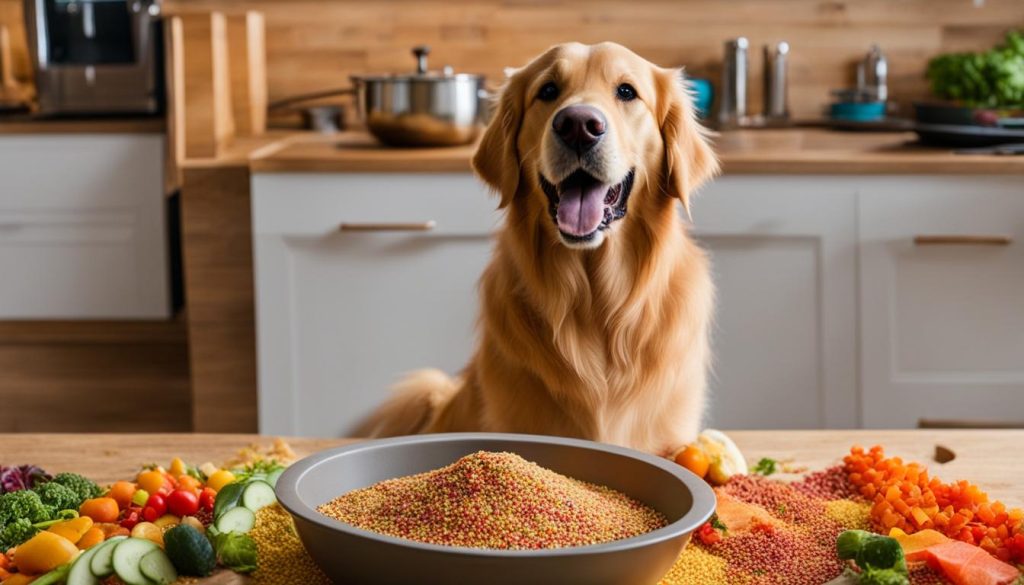
Quinoa as a Dog Treat
Quinoa can be a wonderful and nutritious option when it comes to treating your dog. Not only is it packed with essential nutrients, but it also makes for a tasty and healthy reward. One great way to incorporate quinoa into your dog’s treat repertoire is by mixing it with peanut butter. The combination of the nutty flavor of quinoa and the deliciousness of peanut butter is sure to please your furry friend.
To make quinoa and peanut butter treats, simply cook the quinoa according to the package instructions and let it cool. Then, mix it with a scoop of peanut butter until well combined. Roll the mixture into small balls and place them on a baking sheet. Pop them into the freezer for a couple of hours until they firm up. Once frozen, these treats can be stored in an airtight container in the freezer and served to your dog as a special treat.
Not only are these homemade quinoa treats a healthier alternative to store-bought options, but they also allow you to control the ingredients and avoid any additives or preservatives that may not be suitable for your dog. Plus, the combination of quinoa and peanut butter offers a good balance of protein and healthy fats, making it a nutritious choice for your furry companion.
Dog-Friendly Quinoa Treat Recipe:
- Cook quinoa according to package instructions and let it cool.
- Mix cooked quinoa with peanut butter until well combined.
- Roll mixture into small balls and place on a baking sheet.
- Freeze for a couple of hours until firm.
- Store in an airtight container in the freezer.
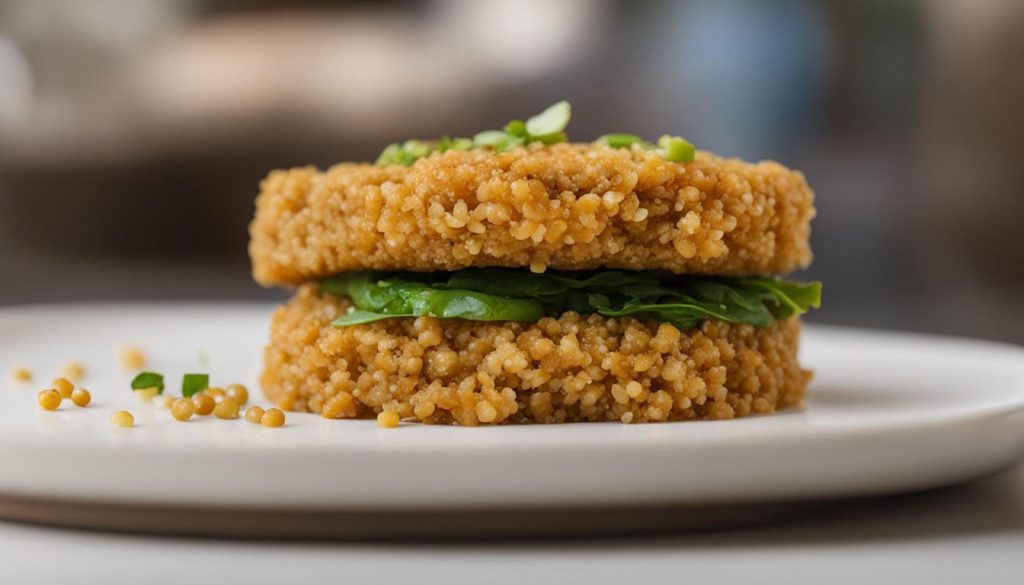
| Treat Name | Ingredients | Instructions |
|---|---|---|
| Quinoa and Peanut Butter Treats |
|
|
Wrapping Up
After careful consideration, it is clear that quinoa can be a valuable addition to a dog’s diet. Not only is it a nutritious grain, but it also offers several health benefits for our canine companions. By incorporating quinoa into their meals or serving it as a treat, we can provide them with a wholesome and balanced diet.
However, it is important to exercise caution when introducing quinoa to dogs. Starting with small portions and monitoring their reaction is crucial to ensure their digestive system can handle this new food. Additionally, consulting a veterinarian before making any dietary changes is always recommended to ensure the well-being of our furry friends.
While quinoa is a fantastic option, it is essential to remember that there are other nutritious grains available for dogs as well. Brown rice, oats, and barley are just a few examples of dog-friendly grains that can be safely incorporated into their diet. By diversifying their food options, we can provide our dogs with a variety of nutrients and flavors.
To summarize, quinoa is a nutritious grain that can be safely incorporated into a dog’s diet. However, it is important to introduce it gradually, monitor their reaction, and consult a veterinarian for guidance. By doing so, we can ensure that our dogs enjoy the benefits of incorporating nutritious grains like quinoa into their diet.
FAQ
Is quinoa safe for dogs?
Yes, quinoa is generally safe for dogs to eat. However, it’s important to introduce it gradually and monitor your dog’s reaction.
What should I know about feeding quinoa to dogs?
When feeding quinoa to dogs, it should be cooked and free from harmful ingredients like salt, garlic, or onions. Start with small portions and observe your dog for any digestive issues.
What are the health benefits of quinoa for dogs?
Quinoa is a nutritious grain that provides protein, vitamins, and minerals. It supports a strong immune system and promotes overall well-being in dogs.
How should I introduce quinoa to my dog’s diet?
Start with small amounts of quinoa and gradually increase the portion size. Monitor your dog for any digestive issues or adverse reactions. It’s always best to consult a veterinarian before making any changes to your dog’s diet.
Are there other dog-friendly grains besides quinoa?
Yes, there are other grains that are safe for dogs to eat, including brown rice, oats, and barley. These grains offer similar nutritional benefits and can be prepared and served in a similar way to quinoa.
What precautions should I take when feeding quinoa to dogs?
Avoid giving your dog quinoa directly from your plate, as quinoa recipes may contain harmful ingredients. Always cook quinoa separately for your dog, using plain water or low-sodium chicken broth without any added harmful ingredients.
How can I incorporate quinoa into my dog’s meals?
Quinoa can be mixed with your dog’s regular food in small amounts, providing them with added nutrients. It can also be mixed with other dog-friendly ingredients like pureed pumpkin or vegetables to create a nutritious and flavorful meal.
Can quinoa be used as a dog treat?
Yes, quinoa can be used as a healthy and tasty treat for dogs. By mixing it with peanut butter or other dog-friendly ingredients and rolling it into small balls, you can create homemade treats that offer nutritional benefits.






